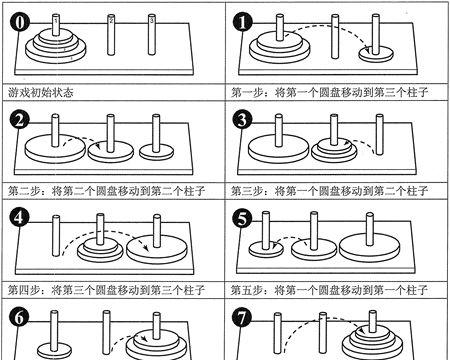汉诺塔是计算机学教科书中常用的游戏,用来说明递归的魔力。该游戏有3个柱子和一组不同大小的圆盘,柱子从圆盘的中心穿过。
游戏开始时,所有圆盘叠放在左侧第一个柱子上,如下图所示:

汉诺塔游戏中的柱子和圆盘
游戏的目标是将所有的圆盘从第一个柱子移动到第三个柱子,同时遵守以下规则:
① 除了被移动时,所有圆盘都必须放在柱子上。
② 一次只能移动一个圆盘。
③圆盘不能放置在比它小的圆盘上面。
现在来看一看游戏的一些玩法示例。最简单的情况是当只有一个圆盘时:在这种情况下,只要将圆盘从第一个柱子移动到第三个柱子就可以一次性完成游戏。
如果有两个圆盘,则需要通过 3 个步骤解决这个游戏:
①将圆盘从第一个柱子移动到第二个柱子(它必须是最上面的一个)。
②将圆盘从第一个柱子移动到第三个柱子。
③将圆盘从第二个柱子移动到第三个柱子。
请注意,虽然游戏的目的是将圆盘从第一个柱子移动到第三个柱子,但是有必要使用第二个柱子作为一些圆盘的临时安放位置。解决方案的复杂性随着要移动的圆盘数量的增加而迅速增加。
移动 3 个圆盘需要 7 步移动,如下图所示:

汉诺塔 3 个圆盘的 7 步解决方案
这个游戏有一个迷人的传说。根据这个传说,河内寺庙里有一群僧侣,他们有 3 个柱子和 64 个圆盘。这些圆盘最初堆放在第一个柱子上,而僧侣们则需要将它们移动到第三个柱子上。当僧侣们完成任务时,世界将会消亡。
现在回到这个问题本身,来考虑当圆盘的数量不做限制时,一般情况下的解决方案。
这个问题可以被描述为:将 n 个圆盘从第一个柱子移动到第三个柱子,使用第二个柱子作为临时柱子。
要理解如何使用循环解决这个问题是非常困难的,但令人高兴的是,设想一个递归解决方案并不困难:如果可以(递归地)将 n-1 个圆盘从第一个柱子移动到第二个柱子,而使用第三个柱子作为临时挂钩,那么最大的圆盘将独自放在第一个柱子上。然后就可以一次性把最大圆盘从第一个柱子移动到第三个柱子。接下来,可以(递归地)将 n-1 个圆盘从第二个柱子移动到第三个柱子,这次使用第一个柱子作为临时柱子。
这个计划可以使用伪代码表示如下。其中,disk 表示圆盘,peg1-3 对应第一个柱子-第三个柱子。
To move n disks from peg 1 to peg 3, using peg 2 as a temporary peg: If n > 0 Then Move n-1 disks from peg 1 to peg 2, using peg 3 as a temporary peg. Move a disk from peg 1 to peg 3. Move n-1 disks from peg 2 to peg 3, using peg 1 as a temporary peg. End If
现在来编写一个实现这个解决方案的函数,打印解决游戏的一系列动作。
以下代码将使用名称而不是数字来描述柱子。该函数的目标是使用临时柱子(peg3)将一叠圆盘从源柱子(peg1)移动到目标柱子(peg2)。
以下是函数的代码:
void moveDisks(int n, string source, string dest, string temp){ if (n > 0) { //将n-1圆盘从源柱子移动到临时柱子 //使用目标柱子作为临时柱子 moveDisks(n – 1, source, temp, dest); //将圆盘从源柱子移动到目标柱子 cout << “Move a disk from ” << source << ” to ” << dest << endl; //将n-1圆盘从临时柱子移动到目标柱子 //使用源柱子作为临时柱子 moveDisks(n – 1, temp, dest, source); }}
基本情况在 n = 0 时发生,并且没有要移动的圆盘。在这种情况下,函数调用将不做任何事情返回。下面的程序演示了该函数。
// This program displays a solution to the towers of Hanoi game.#include <iostream>#include <string>using namespace std;// Function prototypevoid moveDisks(int, string, string, string);int main(){ // Play the game with 3 disks moveDisks (3, “peg 1”, “peg 3”, “peg 2”); cout << “All the disks have been moved!”; return 0;}voidmoveDisks(int n, string source, string dest, string temp){ if (n > 0) { // Move n-1 disks from source to temp // using dest as the temporary peg moveDisks(n-1, source, temp, dest); // Move a disk from source to dest cout << “Move a disk from ” << source << ” to ” << dest << endl; // Move n-1 disks from temp to dest // using.source as the temporary peg moveDisks(n-1, temp, dest, source); }}
程序输出结果:
Move a disk from peg 1 to peg 3
Move a disk from peg 1 to peg 2
Move a disk from peg 3 to peg 2
Move a disk from peg 1 to peg 3
Move a disk from peg 2 to peg 1
Move a disk from peg 2 to peg 3
Move a disk from peg 1 to peg 3

不管你是转行也好,初学也罢,进阶也可,如果你想学编程,进阶程序员~
C语言入门资料:

C语言必读书籍:











